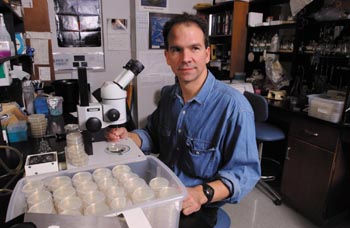
Dr. David Miller and colleagues have cloned and characterized the unc-4 gene and the protein it encodes. UNC-4 is a transcription factor that works in the cell nucleus to turn other genes "off." (photo by Neil Brake)
VUMC researcher studied with new Nobel prize winner
A lecture that Sydney Brenner, one of this year’s Nobel-prize winners in physiology and medicine, gave in 1978 completely changed the life of David Miller, Ph.D., associate professor of Cell Biology. Miller was a graduate student at Rice University in Houston when he went to hear a seminar that Brenner gave at nearby Baylor College of Medicine.
“He presented the idea of using this tiny worm to understand biology, of using genetic approaches to figure out the key molecules in biochemical pathways,” Miller recalled. “I was really swept away by the notion that you could use genetics to dissect a complex process without making any assumptions about what the players are.”
The nematode Caenorhabditis elegans — C. elegans for short — is slightly smaller than an eyelash and normally lives in compost heaps. In 1973, Brenner began championing the idea of using C. elegans as an animal model. The tiny worm is made up of less than 1,000 cells, yet it possesses a nervous system, digestive tract, musculature and reproductive system. Scientists have completely mapped its genome and the stages in its development.
Miller was so taken with this idea that he changed the direction of his career to pursue postdoctoral research with the millimeter-long worm that Brenner was developing into a new animal model. He eventually studied with Brenner himself, who is a professor at the Salk Institute for Biological Studies in La Jolla, California. When Miller came to Vanderbilt, he set up his own “worm farm” and has been studying C.elegans
This year’s Nobel prize is the first to recognize C. elegans research. Along with Brenner, the prize was awarded to John E. Sulston at Cambridge University in England and Robert Horvitz of the Massachusetts Institute of Technology. Brenner was recognized for showing that the worm was useful for studying how cells specialize and organs develop. Sulston discovered that certain cells in the developing worm are destined to die through a process called programmed cell death and he described the visible steps in the cell-death process. And Horvitz identified the first two “death genes” in the worms and showed that humans have a gene similar to one of them.
“It’s very gratifying to those of us in the field,” Miller said. He first heard that his mentor had received the prize while swimming laps yesterday morning when a fellow swimmer, who doesn’t know anything about science, asked him if he’d heard that “some worm guy got the Nobel prize.”
Miller is a member of small cadre of researchers at Vanderbilt who use C.elegans in their research. The others are David Greenstein, Randy Blakely, Alfred George Jr., Kevin Strange, Jeffrey Balser, and Lou DeFelice.
A multi-media feature about C. elegans research at Vanderbilt appears in Exploration, Vanderbilt’s online research magazine, at http://exploration.vanderbilt.edu/news/news_worm.htm.













